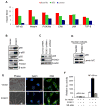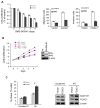FOXC1 regulates the functions of human basal-like breast cancer cells by activating NF-κB signaling
- PMID: 22249250
- PMCID: PMC3961006
- DOI: 10.1038/onc.2011.635
FOXC1 regulates the functions of human basal-like breast cancer cells by activating NF-κB signaling
Abstract
Human basal-like breast cancer (BLBC) is an enigmatic and aggressive malignancy with a poor prognosis. There is an urgent need to identify therapeutic targets for BLBC, because current treatment modalities are limited and not effective. The forkhead box transcription factor FOXC1 has recently been identified as a critical functional biomarker for BLBC. However, how it orchestrates BLBC cells was not clear. Here we show that FOXC1 activates the transcription factor nuclear factor-κB (NF-κB) in BLBC cells by increasing p65/RelA protein stability. High NF-κB activity has been associated with estrogen receptor-negative breast cancer, particularly BLBC. The effect of FOXC1 on p65/RelA protein stability is mediated by increased expression of Pin1, a peptidyl-prolyl isomerase. FOXC1 requires NF-κB for its regulation of cell proliferation, migration and invasion. Notably, FOXC1 overexpression renders breast cancer cells more susceptible to pharmacological inhibition of NF-κB. These results suggest that BLBC cells may rely on FOXC1-driven NF-κB signaling. Interventions of this pathway may provide modalities for the treatment of BLBC.
Conflict of interest statement
Dr. Wang, Dr. Ray, Dr. Bagaria, and Dr. Cui are named inventors on patent applications regarding the role of FOXC1 in cancer.
Figures



Similar articles
-
Identification of EGF-NF-κB-FOXC1 signaling axis in basal-like breast cancer.Cell Commun Signal. 2017 Jun 19;15(1):22. doi: 10.1186/s12964-017-0180-3. Cell Commun Signal. 2017. PMID: 28629477 Free PMC article.
-
The prolyl isomerase Pin1 regulates the NF-kappaB signaling pathway and interleukin-8 expression in glioblastoma.Oncogene. 2009 Oct 22;28(42):3735-45. doi: 10.1038/onc.2009.232. Epub 2009 Aug 10. Oncogene. 2009. PMID: 19668231 Free PMC article.
-
FOXC1 identifies basal-like breast cancer in a hereditary breast cancer cohort.Oncotarget. 2016 Nov 15;7(46):75729-75738. doi: 10.18632/oncotarget.12370. Oncotarget. 2016. PMID: 27708239 Free PMC article.
-
FOXC1: an emerging marker and therapeutic target for cancer.Oncogene. 2017 Jul 13;36(28):3957-3963. doi: 10.1038/onc.2017.48. Epub 2017 Mar 13. Oncogene. 2017. PMID: 28288141 Free PMC article. Review.
-
FOXC1, the new player in the cancer sandbox.Oncotarget. 2017 Nov 28;9(8):8165-8178. doi: 10.18632/oncotarget.22742. eCollection 2018 Jan 30. Oncotarget. 2017. PMID: 29487724 Free PMC article. Review.
Cited by
-
RBBP6, a RING finger-domain E3 ubiquitin ligase, induces epithelial-mesenchymal transition and promotes metastasis of colorectal cancer.Cell Death Dis. 2019 Nov 4;10(11):833. doi: 10.1038/s41419-019-2070-7. Cell Death Dis. 2019. PMID: 31685801 Free PMC article.
-
Identification of a novel microRNA-141-3p/Forkhead box C1/β-catenin axis associated with rheumatoid arthritis synovial fibroblast function in vivo and in vitro.Theranostics. 2020 Apr 6;10(12):5412-5434. doi: 10.7150/thno.45214. eCollection 2020. Theranostics. 2020. PMID: 32373221 Free PMC article.
-
TM-233, a novel analog of 1'-acetoxychavicol acetate, induces cell death in myeloma cells by inhibiting both JAK/STAT and proteasome activities.Cancer Sci. 2015 Apr;106(4):438-46. doi: 10.1111/cas.12616. Epub 2015 Mar 10. Cancer Sci. 2015. PMID: 25613668 Free PMC article.
-
Reciprocal regulation of forkhead box C1 and L1 cell adhesion molecule contributes to triple-negative breast cancer progression.Breast Cancer Res Treat. 2024 Apr;204(3):465-474. doi: 10.1007/s10549-023-07177-7. Epub 2024 Jan 6. Breast Cancer Res Treat. 2024. PMID: 38183514 Free PMC article.
-
Forkhead box C1 promotes metastasis and invasion of non-small cell lung cancer by binding directly to the lysyl oxidase promoter.Cancer Sci. 2019 Dec;110(12):3663-3676. doi: 10.1111/cas.14213. Epub 2019 Nov 12. Cancer Sci. 2019. PMID: 31597217 Free PMC article.
References
-
- Dairkee SH, Puett L, Hackett AJ. Expression of basal and luminal epithelium-specific keratins in normal, benign, and malignant breast tissue. J Natl Cancer Inst. 1988;80(9):691–5. Epub 1988/07/06. - PubMed
-
- Perou CM, Sorlie T, Eisen MB, van de Rijn M, Jeffrey SS, Rees CA, et al. Molecular portraits of human breast tumours. Nature. 2000;406(6797):747–52. - PubMed
-
- Rakha EA, Reis-Filho JS, Ellis IO. Basal-like breast cancer: a critical review. J Clin Oncol. 2008;26(15):2568–81. - PubMed
Publication types
MeSH terms
Substances
Grants and funding
LinkOut - more resources
Full Text Sources
Other Literature Sources
Medical
Miscellaneous

